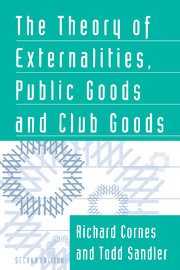Book contents
- Frontmatter
- Contents
- List of tables and figures
- Preface
- Part I Introduction to the theory of externalities, public goods, and club goods
- Part II Externalities
- Part III Public goods
- Part IV Clubs and club goods
- Part V Applications and future directions
- 17 Empirical estimation and public goods
- 18 Applications and empirics
- 19 Conclusions and directions for future research
- References
- Author index
- Subject index
17 - Empirical estimation and public goods
Published online by Cambridge University Press: 05 June 2012
- Frontmatter
- Contents
- List of tables and figures
- Preface
- Part I Introduction to the theory of externalities, public goods, and club goods
- Part II Externalities
- Part III Public goods
- Part IV Clubs and club goods
- Part V Applications and future directions
- 17 Empirical estimation and public goods
- 18 Applications and empirics
- 19 Conclusions and directions for future research
- References
- Author index
- Subject index
Summary
Although this book is primarily concerned with the theory of externalities, public goods, and clubs, we explore applications in this chapter and the next. This chapter focuses on four techniques developed to estimate the demand for public goods: a single equation with lagged spillins, a system of simultaneous equations, an equation for the median voter, and a representation with spatial autoregression attributes. For the four cases, market-based data are used to generate the demand equations. Empirical studies that are associated with related concepts – reaction paths and expenditure equations – are also addressed.
The empirical applications here involve pure public goods, impure public goods, and externalities. For impure public goods, we are especially interested in the demand for an activity that yields private and public joint products. In particular, we put forward a method for distinguishing between the demand for a pure public good and that for an activity yielding joint products. We also review an empirical procedure for differentiating between a median voter and an oligarchy choice model of demand for a public good. Two additional test techniques are presented to distinguish between alternative technologies of public supply aggregation (i.e., weakest link and best shot), or between allocative processes (i.e., Lindahl versus Nash), when analyzing the demand for a public good.
A vast literature has developed since the 1960s concerning the estimation of demand for public goods. Our intent is not to survey this literature, but instead to give the flavor of some of the key issues, while illustrating the theoretical principles developed in the earlier chapters.
- Type
- Chapter
- Information
- The Theory of Externalities, Public Goods, and Club Goods , pp. 483 - 505Publisher: Cambridge University PressPrint publication year: 1996



